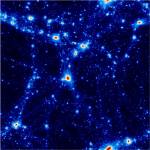
The site's hierarchy
Navigation
| M | T | W | T | F | S | S |
|---|---|---|---|---|---|---|
| 23 | 24 | 25 | 26 | 27 | 28 | 1 |
| 2 | 3 | 4 | 5 | 6 | 7 | 8 |
| 9 | 10 | 11 | 12 | 13 | 14 | 15 |
| 16 | 17 | 18 | 19 | 20 | 21 | 22 |
| 23 | 24 | 25 | 26 | 27 | 28 | 29 |
| 30 | 31 | 1 | 2 | 3 | 4 | 5 |
- Les premiers zoom de galaxies sont accessibles
- Le halo FOF 6133 de la boite Horizon L et le halo FOF 544 de Horizon S ont été resimulés avec plusieurs techniques de zoom. Il est important que chaque "zoomer" valide sa méthode, avant de lancer une campagne de zoom sur un plus grand cataloque.
- Les données de la simulation Mare Nostrum sont disponibles
- 34 snapshots jusqu’à z=4 sont accessibles sur horizon3 et sur le serveur de fichiers de l’IDRIS à la collaboration Horizon.
- Méso Machine HPC1 opérationnelle
- Depuis le 23 Octobre 2005, la Méso machine du site horizon est operationnelle. Elle correspond à 3 quadriprocesseurs avec chacun 64 Giga de RAM reliés par infiniband, ainsi qu’un access conséquent (sur une base de projet dédié) au reste de la ferme). Son acces est ouvert a toute personne de la collaboration ayant acces à la minigrille et qui en fait la demande a admin-minigrille
- http://
- Workshop Horizon le 14 et 15 novembre 2005
- Il aura lieu à Paris les 14 et 15 novembre 2005 (prévoir une nuit sur place). L’enregistrement est ouvert dans la rubrique "meeting!"
- http://
DVR

DVR is:
fast - uses the modern shear-warp algorithm,
easy - just load your dataset and drag the mouse to move around the volume,
scalable - runs in parallel on clusters, and
flexible - can be scripted via Tcl.
DVR was developed at The Centre for Astrophysics and Supercomputing, at Swinburne University of Technology, funded by an Expertise Grant (EPPNSW049) from the Victorian Partnership for Advanced Computing (VPAC). Its home page can be found here. The principal investigators on the grant were David Barnes and Paul Bourke, and the design and coding were accomplished by Brett Beeson. We gratefully acknowledge Jürgen Schulze for providing the core rendering code (Virvo) on which we built the distributed system.
A paper describing DVR has been published (Beeson, Barnes & Bourke, 2003, "A distributed-data implementation of the perspective shear-warp volume rendering algorithm for visualisation of large astronomical cubes," Publications of the Astronomical Society of Australia. 20, 300). The accepted version is available here in pdf format.
DVR is available for download! It will build on most Linux systems, as well as the Darwin (Mac OS X) operating system, and Sun Solaris. X-Windows (eg. XFree86, XDarwin, ...) is required, as well as a recent version of Tcl and the Tk Toolkit (versions 8.3 and 8.4 are known to work). The GNU compiler collection version 3.1.0 or upwards are required. As DVR is oriented towards astronomy data, the CFITSIO and CCfits libraries are necessary to support standard astronomy FITS files. We have recently added limited support for HDF format files using HDF v. 4.1r5.
DVR can be run on a single machine, or on a cluster with rsh or ssh installed. No support is guaranteed, but you may submit questions regarding DVR to Brett Beeson or David Barnes, and we may be able to assist. DVR code version Date released
DVR has also been deployed across a private compute and data grid (Rixon et al., 2004, "VIsualizing Data Cubes on the Grid," Astronomical Data Analysis Software and Systems XII, submitted). An interface to DVR also exists for the AIPS++ viewer.
